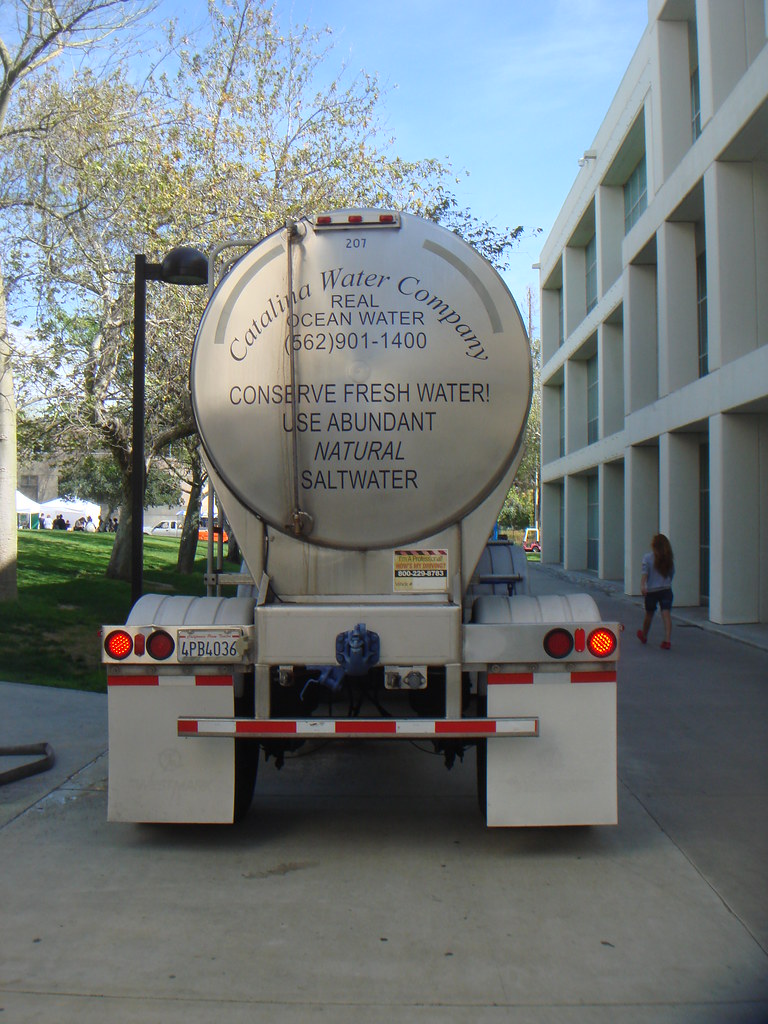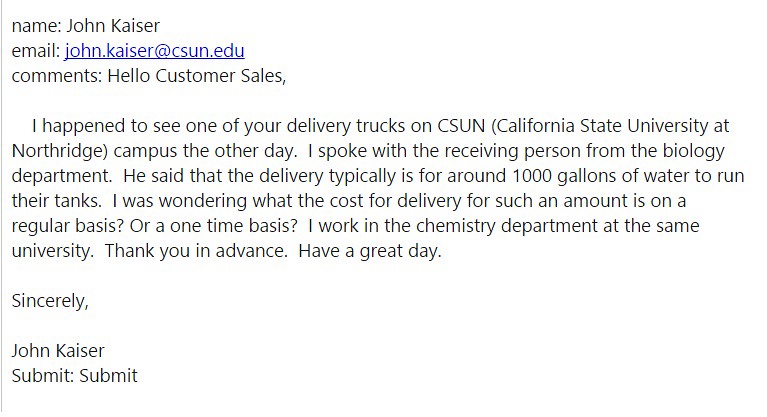Sea Water For Sale?
Who would be interested in purchasing sea water? That is a question that I asked myself after looking down from the 3rd floor of my building (returning to lunch) to find the sight in the picture below:
My first thought after looking down was "oh just another delivery...". Why would I say such a statement? When you work for a university, there are many delivery trucks that come on and off campus for various reasons. Further, working in a research based department, there are many deliveries which occur on a regular basis.
One such delivery is liquid cryogens (nitrogen and helium) which keep our scientific instruments running optimally at all times. That is the basis of my job is to aside from all of the other duties, to maintain the cryogens and liquids/gases in various instruments to ensure optimal and working order for either research or teaching purposes. With that in mind, the sight of the truck above, really did not phase me too much.
Although, after zooming in on the rear of the truck, I noticed the name of the company that the truck was from. The name caused me to wonder and stop for that matter. Here is a close up of the rear of the truck shown below:
The name of the company is "Catalina Water Company" with a sub-slogan that reads "Real Ocean Water." Why would anyone buy ocean water? That is what immediately went through my mind. Of course, then I remembered who was on the first floor of the building -- the Marine Biology Department. Oh, now I get it. Wow.
As you can see by the picture angle, I walked down to the truck to get a closer picture. Additionally, I asked the equivalent employee of the Marine Biology Department of myself -- how many gallons does the department purchase? He said kindly, a little over 1000 gallons on a regular basis. In the basement, there is a tank that holds around 1000 gallons of water -- sea water.
What do they use sea water for?
I was having a brain fart...to fill up their saltwater tanks for their fish. Additionally, I remembered that a couple of years ago, I was trying to get an order (work order request filled) done by the machine shop and was told that the current project had priority. I wondered what type of project would take priority that would require all of the staff members -- must be a huge project?
As I was later to find out, the huge project was a gigantic tank that had multiple compartments and a complex geometry to accommodate research that simulated a certain depth in the ocean. I imagine that there is a large amount of that normal delivery that is devoted to this research as well.
After finding out the required amount that was normally delivered, I wondered about the price of the water.
How much does a company like 'Catalina Water Company' charge for 1000 gallons of sea water?
How much can a single tanker deliver to make the cost worthwhile?
How Much Does A 1000 Gallons Cost For Delivery?
The staff member in the biology department said that the water was filtered 'coarsely' one time. Initially, I thought -- wow -- what a great business idea. Pull water from an abundant supply and just drive it around and deliver the water to universities, businesses, and other venues that require large amounts of sea water (zoo's?, aquariums?). I decided to go onto the website and inquire about the price as shown below:
To which, I received this response within an hour shown below:
That means CSUN pays around $280 for a delivery of 1000 gallons of water. This made me question the capacity of the truck that delivered the water. At what capacity does the price make sense? I am not a business person, so I will restate the question. What is the capacity of a single tanker truck? Thanks to the internet, the answer can be found with a small amount of searching on my part (or yours or anyone for that matter -- just try). Below is a schematic I found on the website 'Alibaba.com' for tanker trucks:
Source: Alibaba
As you can see the internet is full of specific information available. I was pleasantly surprised to find the exact information easily. Shown above is the compartmentalized tanker. If we add up all of the volumes listed, the total comes out to 45,000 Liters. I converted the volume to gallons in order to determine the total amount that could be carried in 'one run' or delivery to multiple vendors as shown below:
That was the volume listed in the diagram. According to the specifications, the total capacity of a single tanker sold on 'Alibaba.com' is 60 cubic meters. The conversion from cubic meters to gallons is shown below:
With the total volume range known of single tankers -- 12 to 16 thousand gallons, the amount of revenue generated by a single tanker truck delivery run can be determined. The assumption here is that the price used to determine the revenue generated is based on the discount given to CSUN. Therefore, a more accurate revenue would be variable based on the cost charged to different vendors. I calculated the range of revenue that a single tanker truck would generate -- given that a full single tanker truck can only deliver a single payload in a day. The calculations are shown below:
At first sight, the amount might tempt you to think that the revenue generated must be making the owners millions of dollars. Upon further inspection, one could consider the cost of maintaining the tankers (made of metal) with carrying corrosive sea water. Each of the metal valves has to be maintained. Additionally, the fuel cost along with the cost of paying the driver/deliverer.
Conclusion
Evidently, there is a market for sea water. Just like there is a market for liquid nitrogen. Both are pulled from natural resources. The company 'Airgas' has a manufacturing plant where nitrogen is pulled out of the air and condensed into liquid form and sold to vendors such as CSUN. Catalina Water Company does the same with water taken from the ocean. Why do I bring the comparison up in the conclusion?
At first sight, I thought what a great business plan. Super simple. Upon further thought, the price has to match the demand. And what I first thought to be a trivial business serves a large and respectable purpose. Assisting the research in Marine Biology along with other vendors by providing sea water is respectable and not a trivial process. In fact, I wonder how the company maintains the fleet of equipment dealing with such corrosive water on a large throughput basis.
I hope that you have enjoyed the post. Next time that you are near the ocean, you can think of this post. All that water does not go to waste. Think of the reason that one might want to have 'real sea water' as opposed to water that has properly controlled pH level. I am sure that even though the water is filtered, there are still microorganisms that are in the sea water which provide a more realistic environment to the marine life in the storage tanks. Until next time, have a great day.








Interesting.
ReplyDeleteYou have a inquisitive mind!
Hello,
DeleteThank you for the compliment. I hope that you enjoy the content on this site. Have a great day.
Sincerely,
Mike
Very high and nice post. Tankers for hire are vessels available for transporting liquid cargo such as oil, chemicals, or liquefied natural gas (LNG). These vessels can be leased by companies needing to transport large quantities of liquid goods across seas and oceans. Tanker hire services provide flexible solutions for businesses, offering various vessel sizes and specifications to suit specific cargo requirements. They play a crucial role in global logistics, facilitating the movement of essential commodities worldwide. Unlock the full potential of tankers for rent by clicking here to access our exclusive content, including how-to guides, FAQs, and customer testimonials.
ReplyDelete